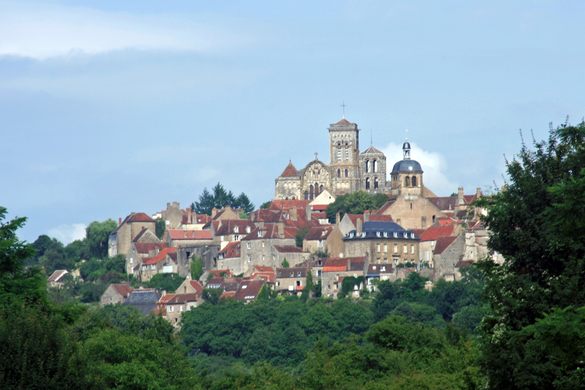La Basilique Sainte-Marie-Madeleine
This church sits upon a peaceful hill and a long, turbulent history.
Amid the fields of sleepy countryside that stretch toward the horizon is the small village of Vézelay, its old stone buildings built upon a hill. The town’s slender walkways and narrow cobblestone streets dodge bakeries and lampposts as they wind upwards to the edifice standing atop the village: Basilique Sainte-Marie-Madeleine, a monastic church that dates back to the 9th and 10th centuries.
If you arrive at the right time of day, you’ll see nuns filing into the Basilique Sainte-Marie-Madeleine (Basilica of Mary Magdalene) for service and song. Like the monks who also belong to the church, they are dressed in white robes, calmly moving about the grand and towering space. A Benedictine abbey church, the basilica is decorated with detailed sculptures and great works of Romanesque art and architecture. The columns lining the church’s nave and choir are covered in scenes carved from the Bible.
Vézelay and its church were a key point in the journey for pilgrims passing through to Santiago de Compostela in Galicia in northwest Spain—a factor that put pressure on the church to expand in its early days. Long known as the Abbey of Vézelay, the church came under the title basilica only in 1920.
The history of the basilica has plenty of ups and downs. Relics from Mary Magdalene were brought to Vezelay in 882, items that would provide mystery and drama in coming years. In 1120, a major fire ravaged the nave, and another in 1165. In the early centuries, the church was in the middle of local attacks and revolts, at least in one instance over raised taxes to cover church expansions.
In 1166, it was the site where the exiled Archbishop of Canterbury, Thomas Beckett, pronounced the solemn condemnation of his king, Henry II. It was also where several key meetings took place during the Second and Third Crusades. Later, in the 1500s, it underwent further damage when the Huguenots came through, and again suffered damage during the French Revolution.
Today, however, the basilica stands fully restored, open every day for the public to wander through and ponder. Make sure to notice how the church’s position takes into consideration the Earth’s orientation with the sun—an architectural detail that floods the nave with a special scattering of light at midday on the summer solstice.
After a millennium’s worth of wear and tear, the basilica underwent major repairs and restoration in the 1800s, and today, it feels pristine. The ceiling soars upwards into the sky, and everywhere you look, your eyes will light upon different religious scenes, which don’t depict sinners and unbelievers in a very flattering light (think: pig snouts and elephant ears). To fully understand the complex range of religious symbolism and imagery in the church would take much dedication and effort — and a very long ladder.
Know Before You Go
The basilica is open every day from 7am to 8pm. You can check the Visitors Center for information on guided tours.
Community Contributors
Added by
Edited by
The Atlas Obscura Podcast is Back!





















Follow us on Twitter to get the latest on the world's hidden wonders.
Like us on Facebook to get the latest on the world's hidden wonders.
Follow us on Twitter Like us on Facebook